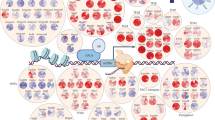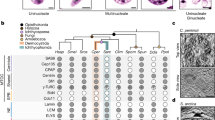Abstract
Mammalian Mip/LIN-9 is a cell cycle regulatory protein that is negatively regulated by CDK4/cyclin D. It has been demonstrated that Mip/LIN-9 collaborates with B-Myb during S and G2/M in the induction of cyclins A and B, and CDK1. The ortholog of Mip/LIN-9 in D rosophila, Mip130, is part of a large multisubunit protein complex that includes RBF, repressor E2Fs and Myb, in what was termed the dREAM complex. A similar complex, although lacking B-Myb, was also described in Caenorhabditis elegans. Here, we demonstrate that unlike Drosophila, Mip/LIN-9 has mutually exclusive and cell cycle-phase-specific interactions with the mammalian orthologs of the dREAM complex. In G0/early G1, Mip/LIN-9 forms a complex with E2F4 and p107 or p130, while in late G1/S phase, it associates with B-Myb. The separation of Mip/LIN-9 from p107,p130/E2F4 is likely driven by phosphorylation of the pocket proteins by CDK4 since Mip/LIN-9 fails to interact with phosphorylated forms of p107,p130. Importantly, the repressor complex that Mip/LIN-9 forms with p107 takes functional precedence over the transcriptional activation linked to the Mip/LIN-9 and B-Myb interaction since expression of p107 blocks the activation of the cyclin B promoter triggered by B-Myb and Mip/LIN-9.
This is a preview of subscription content, access via your institution
Access options
Subscribe to this journal
Receive 50 print issues and online access
$259.00 per year
only $5.18 per issue
Buy this article
- Purchase on Springer Link
- Instant access to full article PDF
Prices may be subject to local taxes which are calculated during checkout






Similar content being viewed by others
Abbreviations
- CDK:
-
cyclin-dependent kinase
- dREAM:
-
D rosophila RB, E2F and Myb complex
- IP:
-
immunoprecipitation
- mAb:
-
monoclonal antibody
- Mip:
-
Myb-interacting protein
- pAb:
-
polyclonal antibody
- WB:
-
western blotting
References
Bartsch O, Horstmann S, Toprak K, Klempnauer HK, Ferrari S . (1999). Identification of cyclin A/Cdk2 phosphorylation sites in B-Myb. Eur J Biochem 260: 384–391.
Beall LE, Bell M, Georlette D, Botchan RM . (2004). Dm-myb mutant lethality in Drosophila is dependent upon mip130: positive and negative regulation of DNA replication. Genes Dev 18: 1667–1680.
Beall LE, Manak RJ, Zhou S, Bell M, Lipsick SJ, Botchan RM . (2002). Role for a Drosophila Myb-containing protein complex in site-specific DNA replication. Nature 420: 833–837.
Beijersbergen LR, Carlee L, Kerkhoven MR, Bernards R . (1995). Regulation of the retinoblastoma protein-related p107 by G1 cyclin complexes. Genes Dev 9: 1340–1353.
Beitel JG, Lambie JE, Horvitz RH . (2000). The C. elegans gene lin-9, which acts in an Rb-related pathway, is required for gonadal sheath cell development and encodes a novel protein. Gene 254: 253–263.
Bhatt MA, Zhang Q, Harris AS, White-Cooper H, Dickinson H . (2004). Gene structure and molecular analysis of Arabidopsis thaliana ALWAYS EARLY homologs. Gene 336: 219–229.
Bruce LJ, Hurford Jr KR, Classon M, Koh J, Dyson N . (2000). Requirements for cell cycle arrest by p16INK4a. Mol Cell 6: 737–742.
Burgess A, Wigan M, Giles N, Depinto W, Gillespie P, Stevens F et al. (2006). Inhibition of S/G2 phase CDK4 reduces mitotic fidelity. J Biol Chem 281: 9987–9995.
Chipperfield GR, Jones SS, Lo MK, Weinberg AR . (1985). Activation of Ha-ras p21 by substitution, deletion, and insertion mutations. Mol Cell Biol 5: 1809–1813.
Ciemerych AM, Sicinski P . (2005). Cell cycle in mouse development. Oncogene 24: 2877–2898.
Classon M, Dyson N . (2001). p107 and p130: versatile proteins with interesting pockets. Exp Cell Res 264: 135–147.
Classon M, Harlow E . (2002). The retinoblastoma tumour suppressor in development and cancer. Nat Rev Cancer 2: 910–917.
Cobrinik D . (2005). Pocket proteins and cell cycle control. Oncogene 24: 2796–2809.
Dimova KD, Dyson JN . (2005). The E2F transcriptional network: old acquaintances with new faces. Oncogene 24: 2810–2826.
Du W, Pogoriler J . (2006). Retinoblastoma family genes. Oncogene 25: 5190–5200.
Ferguson LE, Horvitz RH . (1989). The multivulva phenotype of certain Caenorhabditis elegans mutants results from defects in two functionally redundant pathways. Genetics 123: 109–121.
Gabrielli GB, Sarcevic B, Sinnamon J, Walker G, Castellano M, Wang QX et al. (1999). A cyclin D-Cdk4 activity required for G2 phase cell cycle progression is inhibited in ultraviolet radiation-induced G2 phase delay. J Biol Chem 274: 13961–13969.
Gagrica S, Hauser S, Kolfschoten I, Osterloh L, Agami R, Gaubatz S . (2004). Inhibition of oncogenic transformation by mammalian Lin-9, a pRB-associated protein. EMBO J 23: 4627–4638.
Gibbs SC, McCurdy NS, Leung LL, Paborsky RL . (1994). Identification of the factor VIIa binding site on tissue factor by homologous loop swap and alanine scanning mutagenesis. Biochemistry 33: 14003–14010.
Hurford Jr KR, Cobrinik D, Lee HM, Dyson N . (1997). pRB and p107/p130 are required for the regulated expression of different sets of E2F responsive genes. Genes Dev 11: 1447–1463.
Joaquin M, Watson JR . (2003). Cell cycle regulation by the B-Myb transcription factor. Cell Mol Life Sci 60: 2389–2401.
Johnson RL, Johnson KT, Desler M, Luster AT, Nowling T, Lewis ER et al. (2002). Effects of B-Myb on gene transcription: phosphorylation-dependent activity and acetylation by p300. J Biol Chem 277: 4088–4097.
Korenjak M, Taylor-Harding B, Binne KU, Satterlee SJ, Stevaux OA, Asland R et al. (2004). Native E2F/RBF complexes contain Myb-interacting proteins and repress transcription of developmentally controlled E2F target genes. Cell 119: 181–193.
Lane S, Farlie P, Watson R . (1997). B-Myb function can be markedly enhanced by cyclin A-dependent kinase and protein truncation. Oncogene 14: 2445–2453.
Leng X, Noble M, Adams DP, Qin J, Harper WJ . (2002). Reversal of growth suppression by p107 via direct phosphorylation by cyclin D1/cyclin-dependent kinase 4. Mol Cell Biol 22: 2242–2254.
Lewis WP, Beall LE, Fleischer CT, Georlette D, Link JA, Botchan RM . (2004). Identification of a Drosophila Myb-E2F2/RBF transcriptional repressor complex. Genes Dev 18: 2929–2940.
Muller-Tidow C, Wang W, Idos EG, Diederichs S, Yang R, Readhead C et al. (2001). Cyclin A1 directly interacts with B-myb and cyclin A1/cdk2 phosphorylate B-myb at functionally important serine and threonine residues: tissue-specific regulation of B-myb function. Blood 97: 2091–2097.
Ness AS . (2003). Myb protein specificity: evidence of a context-specific transcription factor code. Blood Cells Mol Dis 31: 192–200.
Oh HI, Reddy PE . (1999). The myb gene family in cell growth, differentiation and apoptosis. Oncogene 18: 3017–3033.
Osterloh L, Eyss VB, Schmit F, Rein L, Hubner D, Samans B et al. (2007). The human synMuv-like protein LIN-9 is required for transcription of G2/M genes and for entry into mitosis. EMBO J 26: 144–157.
Petrovas C, Jeay S, Lewis ER, Sonenshein EG . (2003). B-Myb repressor function is regulated by cyclin A phosphorylation and sequences within the C-terminal domain. Oncogene 22: 2011–2020.
Pilkinton M, Sandoval R, Song J, Ness AS, Colamonici OR . (2007). Mip/LIN-9 regulates the expression of B-Myb, and the induction of cyclin A, cyclin B and CDK1. J Biol Chem 282: 168–175.
Rayman BJ, Takahashi Y, Indjeian BV, Dannenberg HJ, Catchpole S, Watson JR et al. (2002). E2F mediates cell cycle-dependent transcriptional repression in vivo by recruitment of an HDAC1/mSin3B corepressor complex. Genes Dev 16: 933–947.
Ren S, Rollins JB . (2004). Cyclin C/cdk3 promotes Rb-dependent G0 exit. Cell 117: 239–251.
Robinson C, Light Y, Groves R, Mann D, Marias R, Watson R . (1996). Cell-cycle regulation of B-Myb protein expression: specific phosphorylation during the S phase of the cell cycle. Oncogene 12: 1855–1864.
Sala A, Kundu M, Casella I, Engelhard A, Calabretta B, Grasso L et al. (1997). Activation of human B-MYB by cyclins. Proc Natl Acad Sci USA 94: 532–536.
Sala A, Watson R . (1999). B-Myb protein in cellular proliferation, transcription control, and cancer: latest developments. J Cell Physiol 179: 245–250.
Sandoval R, Xue J, Tian X, Barrett K, Pilkinton M, Baida G et al. (2006). A mutant allele of BARA/LIN-9 rescues the cdk4−/− phenotype by releasing the repression on E2F-regulated genes. Exp Cell Res 312: 2465–2475.
Saville KM, Watson JR . (1998a). B-Myb: a key regulator of the cell cycle. Adv Cancer Res 72: 109–140.
Saville KM, Watson JR . (1998b). The cell-cycle regulated transcription factor B-Myb is phosphorylated by cyclin A/Cdk2 at sites that enhance its transactivation properties. Oncogene 17: 2679–2689.
Sherr JC . (1996). Cancer cell cycles. Science 274: 1672–1677.
Sherr JC . (2004). Principles of tumor suppression. Cell 116: 235–246.
Sherr JC, McCormick F . (2002). The RB and p53 pathways in cancer. Cancer Cell 2: 103–112.
Sherr JC, Roberts MJ . (2004). Living with or without cyclins and cyclin-dependent kinases. Genes Dev 18: 2699–2711.
Takahashi Y, Rayman BJ, Dynlacht DB . (2000). Analysis of promoter binding by the E2F and pRB families in vivo: distinct E2F proteins mediate activation and repression. Genes Dev 14: 804–816.
Vousden HK . (1990). Human papillomavirus oncoproteins. Semin Cancer Biol 1: 415–424.
White-Cooper H, Leroy D, MacQueen A, Fuller TM . (2000). Transcription of meiotic cell cycle and terminal differentiation genes depends on a conserved chromatin associated protein, whose nuclear localization is regulated. Development 127: 5463–5473.
White-Cooper H, Schäfer AM, Alphey SL, Fuller TM . (1998). Transcriptional and post-transcriptional control mechanisms coordinate the onset of spermatid differentiation with meiosis I in Drosophila. Development 125: 125–134.
Xiao XZ, Ginsberg D, Ewen M, Livingston MD . (1996). Regulation of the retinoblastoma protein-related protein p107 by G1 cyclin-associated kinases. Proc Natl Acad Sci USA 93: 4633–4637.
Zhu W, Giangrande HP, Nevins RJ . (2004). E2Fs link the control of G1/S and G2/M transcription. EMBO J 23: 4615–4626.
Ziebold U, Bartsch O, Marais R, Ferrari S, Klempnauer HK . (1997). Phosphorylation and activation of B-Myb by cyclin A-Cdk2. Curr Biol 7: 253–260.
Acknowledgements
This work has been supported by The National Institutes of Health Grant GM54709 (ORC). MP was supported by an NIH Institutional T32 training grant, ‘Training Program in Signal Transduction and Cellular Endocrinology’, T32 DK07739 from the National Institute of Diabetes and Digestive and Kidney Disorders.
Author information
Authors and Affiliations
Corresponding author
Rights and permissions
About this article
Cite this article
Pilkinton, M., Sandoval, R. & Colamonici, O. Mammalian Mip/LIN-9 interacts with either the p107, p130/E2F4 repressor complex or B-Myb in a cell cycle-phase-dependent context distinct from the Drosophila dREAM complex. Oncogene 26, 7535–7543 (2007). https://doi.org/10.1038/sj.onc.1210562
Received:
Revised:
Accepted:
Published:
Issue Date:
DOI: https://doi.org/10.1038/sj.onc.1210562
Keywords
This article is cited by
-
Structure and function of MuvB complexes
Oncogene (2022)
-
Characterization of the zinc finger proteins ZMYM2 and ZMYM4 as novel B-MYB binding proteins
Scientific Reports (2020)
-
LIN9 confers paclitaxel resistance in triple negative breast cancer cells by upregulating CCSAP
Science China Life Sciences (2020)
-
Nitrogen-dependent coordination of cell cycle, quiescence and TAG accumulation in Chlamydomonas
Biotechnology for Biofuels (2019)
-
The cell cycle regulatory DREAM complex is disrupted by high expression of oncogenic B-Myb
Oncogene (2019)



